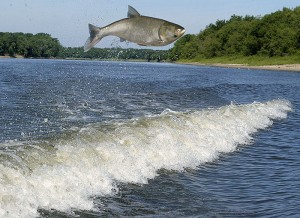Prairie Rivers Network board member Clark Bullard has written op-eds for the Detroit Free Press and the Cleveland Plain Dealer. Dr. Bullard characterizes the failure of the Army Corps of Engineers to deal with the threat of Asian carp as “playing biological Russian roulette with the Great Lakes.”
From the Detroit Free Press, published July 21, 2011
 Imagine living in the path of a rain-swollen river, an aging manmade levee the only thing standing between your community and a devastating flood.
Imagine living in the path of a rain-swollen river, an aging manmade levee the only thing standing between your community and a devastating flood.
As the floodwaters move ever closer, government officials arrive to assure the community that there is no need to worry — the levee was still strong enough to protect the town against most floods.
Would you wait out the flood, knowing there was a chance the levee might not save the town? Or would you take preventive measures to protect your family, your property?
Those are the kinds of questions being asked about an electric fish barrier in the Chicago Waterway System that is supposed to keep Asian carp in the Mississippi River system from invading the Great Lakes.
The electric barrier, built and operated by the U.S. Army Corps of Engineers, isn’t generating enough voltage to repel all sizes of Asian carp.
A Corps-commissioned study found that smaller Asian carp, those less than 5.4 inches long, could breach the electric barrier. The Army Corps was informed in July 2010 that small Asian carp could breach the electric barrier, but the agency decided not to crank up the voltage to repel smaller fish.
The Corps also sat on the study for nine months and refused to release it until the Prairie Rivers Network and Natural Resources Defense Council threatened to sue the agency. That study identified numerous possible holes in the electric barrier.
Releasing the report in March, the Corps acknowledged that the barrier is not producing enough power to prevent smaller Asian carp from reaching Lake Michigan. But agency officials said there was no need to increase the voltage because no small Asian carp have yet been found within 25 miles of the barrier.
The electric fish barrier, as currently operated, is the technological equivalent of an aging levee that has only an 86% chance of protecting a town from floods. Laboratory tests showed that as many as 14% of small fish could penetrate the barrier’s electric field, even at the higher voltages recommended.
The Corps is playing a form of biological Russian roulette with the Great Lakes. If allowed to invade, Asian carp — which eat like pigs, breed like rabbits and rocket out of the water when disturbed by boat motors — could devastate the lakes’ $7-billion fishery and endanger boaters’ lives.
The Corps’ questionable management of the electric barrier is symptomatic of a larger problem within the agency. Four years ago, Congress directed the Corps to prevent Asian carp in the Mississippi River system from invading the Great Lakes. Sadly, the Corps has failed to meet that mandate.
Instead of focusing solely on prevention, the Corps is fixated on reducing the risk of Asian carp invading the Great Lakes.
The emphasis on risk reduction also permeates the Corps’ Great Lakes and Mississippi River Interbasin Study, known as GLMRIS. That $25-million study, which won’t be completed until 2015 at the earliest, is examining the best way to keep Asian carp from invading the Great Lakes. Congress could speed up the GLMRIS study by passing the Stop Asian Carp Act of 2011.
There is only one sure way to prevent Asian carp and other invasive species from moving between the Mississippi River and the Great Lakes: Separate the basins. Because it will take years, if not decades, to separate the basins, the Corps must do everything it can now to ensure that the electric fish barrier prevents Asian carp of all sizes from reaching the Great Lakes.
Asian carp are a flood of biological mayhem bearing down on one of the world’s largest and most valuable freshwater ecosystems. Reducing the risk of Asian carp invading the Great Lakes isn’t good enough. The Corps must prevent this biological nightmare from becoming reality.
—–
From The Cleveland Plain Dealer, published July 30, 2011

Asian carp are poised to lay siege to the Great Lakes, where the menacing invaders — which eat like pigs, breed like mosquitoes and rocket out of the water when disturbed by boat motors — could decimate a $7 billion fishery and endanger boaters’ lives.
Despite the looming threat, the U.S. Army Corps of Engineers remains in denial about the severity of the situation. This is particularly ominous because the corps is leading the federal effort to keep Asian carp out of the Great Lakes.
Earlier this month, the agency announced that its researchers discovered more Asian carp DNA 30 miles beyond an electric barrier in the Chicago Waterway System. That barrier was supposed to keep the invasive fish from reaching Lake Michigan and spreading to the other Great Lakes.
Incredibly, the corps continues to insist that the electric barrier is working, despite the fact that their own studies found the device doesn’t stop all sizes of Asian carp.
A corps-commissioned study concluded in 2009 that Asian carp less than 5.4 inches long could breach the electric barrier. (It takes more electricity to repel small fish because they provide smaller targets than big fish.)
The corps was informed again in July 2010 that smaller Asian carp could breach the electric barrier, but the agency decided not to crank up the voltage to repel the smaller fish. Instead, the corps sat on the study for nine months, refusing to release it until Prairie Rivers Network and the Natural Resources Defense Council threatened to sue the agency.
Released in March 2011, the report revealed fatal flaws in the barrier and acknowledged that it was not producing enough power to prevent smaller Asian carp from reaching Lake Michigan.
Instead of acting on that information, the corps said there was no need to increase the voltage because no small Asian carp have yet been found within 25 miles.
Four months later, the corps announced that it found more Asian carp DNA in waters open to Lake Michigan.
Why was I not surprised by the news?
Because the electric barrier is the technological equivalent of an aging levee that has only an 86 percent chance of protecting a town from all floods. I mention this because the corps’ study found that as many as 14 percent of small fish could penetrate the barrier’s electric field, even at the higher voltages recommended.
As it stands, the corps is playing a form of biological Russian roulette with the Great Lakes. And its questionable management of the barrier is symptomatic of a larger problem within the agency.
Congress in 2007 directed the corps to prevent the transfer of all invasive species, including Asian carp, through aquatic pathways connecting the Great Lakes and the Mississippi River ecosystems. The operative word in that directive was prevent.
Instead of focusing its $25 million Great Lakes and Mississippi River Interbasin Study solely on preventing Asian carp from invading the Great Lakes, the corps is fixated on reducing the risk. This despite the fact that Asian carp DNA continues to be found throughout the Chicago canals; a live specimen also was found last year in waters open to Lake Michigan.
The interbasin study is already years behind schedule and won’t be completed until 2015 at the earliest.
Congress could speed up the study by passing the Stop Asian Carp Act of 2011, which would require the corps to determine by 2012 the best way to separate the Great Lakes and Mississippi River basins.
We already know that there is only one sure way to prevent Asian carp and other invasive species from moving between the Mississippi River and the Great Lakes: Separate the basins.
Because it will take years to accomplish that, the corps must use every weapon at its disposal now to keep Asian carp from reaching Lake Michigan.
Reducing the risk of Asian carp invading the Great Lakes isn’t good enough; the corps must pull out all the stops to prevent this biological nightmare from becoming reality.







